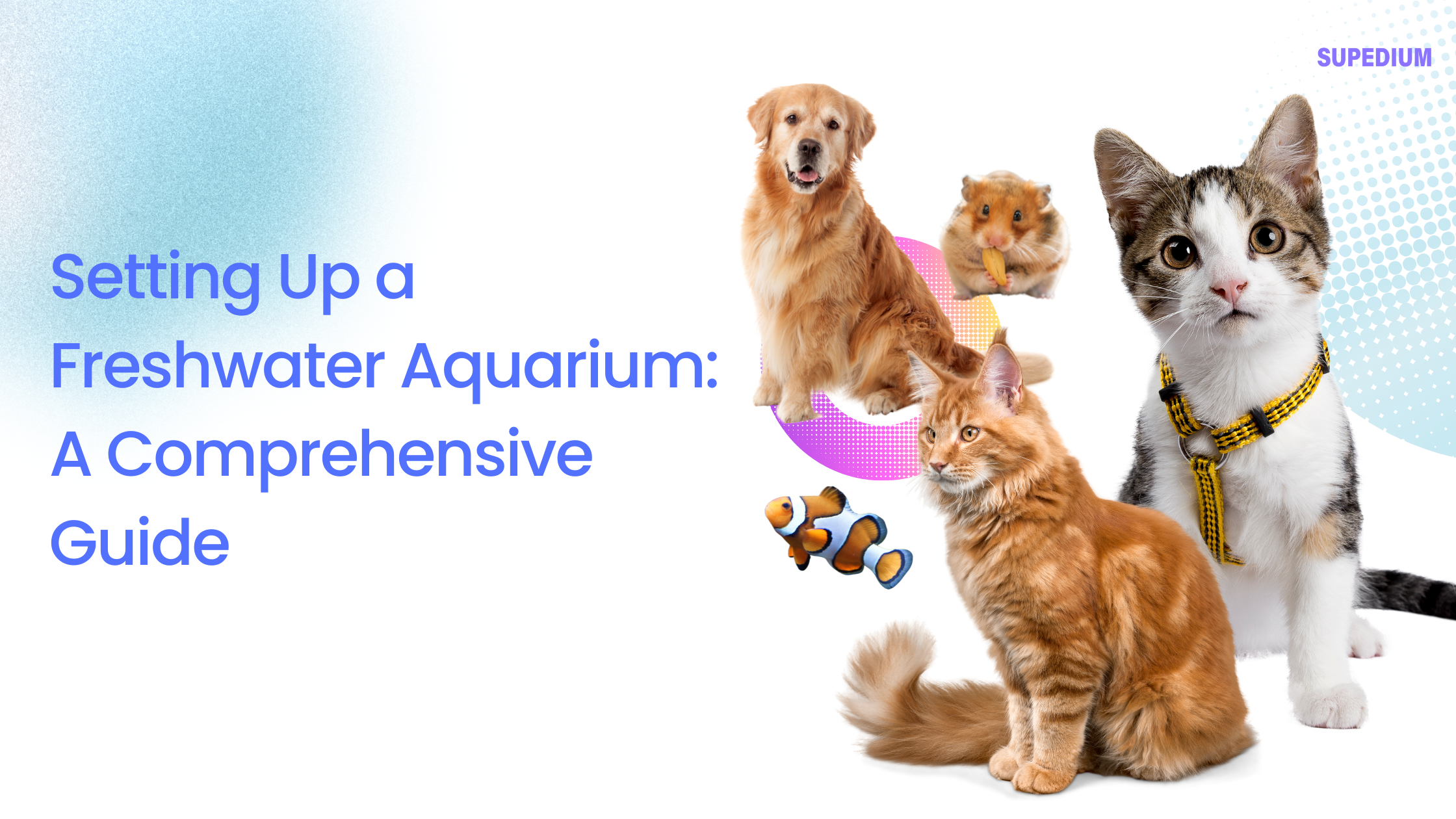Table of Contents
![]()
Setting up a freshwater aquarium is a fascinating and rewarding endeavor. It offers an opportunity to create a vibrant aquatic environment right in your home. Whether you’re a beginner or an experienced aquarist, understanding each step of the process is essential for ensuring a healthy and beautiful aquarium. This comprehensive guide will walk you through the necessary steps to set up and maintain a successful freshwater aquarium.
1. Introduction
Purpose of the Guide
This guide aims to provide a detailed roadmap for setting up a freshwater aquarium, covering everything from planning and equipment to maintenance and troubleshooting. By following these steps, you’ll ensure a smooth setup and long-term success in your aquatic hobby.
Benefits of Freshwater Aquariums
Freshwater aquariums are popular due to their aesthetic appeal, ease of maintenance compared to saltwater setups, and their ability to provide a calming and educational experience. They require less complex equipment and lower costs, making them accessible to beginners while still offering plenty of enjoyment and satisfaction.
2. Planning Your Aquarium
Choosing the Right Aquarium Size
The size of your aquarium plays a crucial role in its overall management. Smaller tanks (10-20 gallons) are easier to handle but can be more challenging to maintain stable water conditions. Larger tanks (30-55 gallons or more) offer more stability and space for fish but require more space and investment. Consider your available space, budget, and the types of fish you wish to keep when selecting your tank size.
Selecting the Location
Choosing the right location for your aquarium is essential. Place the tank on a stable surface that can support its weight. Avoid direct sunlight to prevent excessive algae growth and temperature fluctuations. Ensure the tank is near a power outlet for equipment but not in a high-traffic area to minimize disturbances to the fish.
3. Equipment and Supplies
Tank
Aquariums typically come in glass or acrylic. Glass tanks are less expensive and less prone to scratching, while acrylic tanks are lighter and offer better insulation but are more prone to scratching. Ensure that the tank is of high quality and free from any defects.
Filtration System
A good filtration system is vital for maintaining clean and healthy water. Options include hang-on-back (HOB) filters, canister filters, and internal filters. The choice depends on the tank size and the type of fish. Ensure the filter has an appropriate flow rate and is easy to maintain.
Heater
A heater is necessary to maintain a stable water temperature, which is crucial for the health of your fish. Submersible heaters are commonly used for their efficiency and precision. Check the temperature requirements for your fish species and choose a heater with an adjustable thermostat.
Lighting
Lighting is important for both fish and plant health. LED and fluorescent lights are the most common options. The type of lighting you choose will depend on whether you have live plants and the specific needs of your fish. Aim for a light cycle of about 8-12 hours a day.
Substrate
The substrate, or the material at the bottom of the tank, can vary from gravel to sand or specialized substrates for planted tanks. Gravel is easy to clean and suitable for many setups, while sand is preferred for delicate species or certain types of aquascaping. Rinse the substrate thoroughly before adding it to the tank.
Decorations
Decorations such as rocks, driftwood, and artificial plants add aesthetic value and provide hiding spots for fish. Ensure that all decorations are aquarium-safe, with no sharp edges that could harm fish. Arrange them to create a natural environment and allow swimming space.
Water Conditioner
Tap water often contains chlorine and other chemicals harmful to fish. Use a water conditioner to neutralize these substances before adding water to the tank.
Testing Kits
Regular testing of water parameters is crucial for maintaining a healthy aquarium. Essential tests include pH, ammonia, nitrite, nitrate, and hardness. Test kits help you monitor and adjust water quality as needed.
4. Setting Up the Aquarium
Cleaning the Tank
Before setting up, clean the tank and equipment with water only—avoid using soap or other cleaning agents. Rinse thoroughly to remove any residues that could harm the fish.
Placing the Substrate
Add and spread the substrate evenly across the bottom of the tank. The depth should be sufficient to anchor plants and allow for easy cleaning. Rinse the substrate before placing it in the tank to remove dust and debris.
Installing Equipment
Set up the filtration system, heater, and lighting according to the manufacturer’s instructions. Position the filter and heater in a way that ensures good water circulation and temperature distribution.
Adding Decorations
Place your decorations in the tank, ensuring they are secure and arranged to create a natural environment. Avoid overcrowding the tank, leaving ample swimming space for the fish.
Filling the Tank with Water
Fill the tank slowly to avoid disturbing the substrate and decorations. Use a plate or bowl to deflect the water flow if necessary. Once filled, add the water conditioner to make the water safe for fish.
5. Cycling the Aquarium
Understanding the Nitrogen Cycle
The nitrogen cycle is crucial for establishing a healthy aquarium environment. It involves the conversion of toxic ammonia produced by fish waste into less harmful nitrites and then nitrates by beneficial bacteria.
Types of Cycling
- Fishless Cycling: This method involves adding an ammonia source to the tank to stimulate bacterial growth without fish. It’s a more humane option as it avoids exposing fish to harmful conditions.
- Fish-in Cycling: This method involves introducing a few hardy fish to help kickstart the cycle. It requires careful monitoring and water changes to protect the fish from toxic levels of ammonia and nitrite.
Monitoring and Testing
Regularly test water parameters for ammonia, nitrite, and nitrate levels. The cycling process can take several weeks. During this time, perform partial water changes as needed to maintain water quality.
Adjusting and Maintaining Parameters
Monitor and adjust water parameters to keep them within the ideal range for your fish species. Regular testing helps ensure that the cycle is progressing and that water conditions remain stable.
6. Introducing Fish
Choosing Fish
Research fish species that are compatible with each other and suitable for your tank size. Consider factors such as adult size, temperament, and specific care requirements. A balanced mix of species can create a dynamic and harmonious aquarium.
Acclimating Fish
Proper acclimation is essential to reduce stress and prevent shock. Float the sealed bag containing the fish in the tank for about 15 minutes to equalize temperature. Gradually introduce tank water into the bag before releasing the fish.
Introducing Fish to the Tank
Introduce fish to the tank slowly to avoid overloading the filtration system and causing spikes in toxins. Monitor fish behavior and water quality closely during the first few weeks.
7. Ongoing Maintenance
Regular Tasks
- Water Changes: Perform partial water changes (typically 10-20% weekly) to remove accumulated waste and maintain water quality.
- Filter Maintenance: Clean or replace filter media according to the manufacturer’s recommendations to ensure efficient filtration.
- Parameter Checking: Regularly test and adjust water parameters to keep them within optimal ranges for your fish.
Feeding
Feed fish a varied diet appropriate for their species and size. Avoid overfeeding, as uneaten food can contribute to water pollution. Feed small amounts that fish can consume within a few minutes.
Health Monitoring
Observe fish for any signs of illness or stress, such as changes in behavior, discoloration, or unusual swimming patterns. Address any health issues promptly and seek advice if needed.
8. Troubleshooting Common Issues
Algae Growth
Algae growth can be caused by excess nutrients and light. Reduce light duration, improve water quality, and consider adding algae-eating fish or invertebrates.
Water Cloudiness
Cloudy water may result from bacterial blooms or unclean substrate. Ensure proper filtration and perform regular cleaning to resolve this issue.
Fish Health Problems
Monitor for symptoms of common diseases, such as white spots, fin rot, or fungus. Treat affected fish with appropriate medications and consult an expert if necessary.
9. Additional Considerations
Adding Plants
Live plants can enhance the beauty of the aquarium and improve water quality. Choose plants based on their light and substrate needs and consider their growth rate. Regularly trim and maintain plants to prevent overgrowth.
Upgrading Equipment
As your aquarium evolves, you may need to upgrade equipment. Larger tanks or more advanced filtration systems can improve performance and accommodate a growing fish population.
Aquarium Aesthetics
Arranging plants and decorations aesthetically adds to the enjoyment of your aquarium. Experiment with different layouts to create a visually pleasing and functional setup.
10. Conclusion
Summary of Key Steps
Setting up a freshwater aquarium involves careful planning, selecting the right equipment, and following a structured setup process. Regular maintenance and attention to water quality are essential for a thriving aquatic environment.
Encouragement for the Hobby
Maintaining a freshwater aquarium can be a fulfilling and enjoyable hobby. With proper setup and care, you’ll create a beautiful and healthy habitat for your fish, offering both relaxation and education.
By adhering to this comprehensive guide, you’ll be well on your way to creating a thriving freshwater aquarium that brings joy and tranquility to your home.
Share This





Be the first to comment